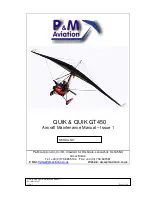
Flight Manual
Cavalon
SECTION 3
EMERGENCY PROCEDURES
RSUK0287_POH_Cavalon
Revision 2, Issue Date 24.06.2015
3-4
Select a suitable landing site from safe altitude, considering slope, wind speed and
direction
Fly a reconnaissance pattern to check for obstacles, especially power lines, wires,
and cables in the approach and go-around path
Overfly the landing site to check for obstructions such as fences, ditches, rocks,
height of vegetation, and select most suitable touch-down zone
Perform a normal approach and touch-down into wind with minimal ground speed
3.8
Flight Control Malfunction
In case of a flight control failure the gyroplane can be controlled with the remaining primary
and secondary controls, including power and trim. An immediate reduction of power, and
corresponding reduction in speed may be necessary to avoid pitch oscillations (phugoid) or
other effects affecting dynamic or static stability. Navigate to a suitable landing site with
wide and shallow turns and approach against the wind.
3.8.1
Engine Power Control / Throttle
Throttle jammed open or max
Navigate to a suitable landing site with the power set. If over safe terrain, magneto switches
may be used to control power. When within gliding distance to the selected landing site,
shut-down engine to perform a power-off landing as per Emergency Procedure “Engine
failure”.
NOTE
In case of a control cable breakage the carburettor will be automatically set to
full throttle position.
Throttle jammed closed
Land as per Emergency Procedure “Engine failure”. Residual power may be used to extend
the glide.
3.8.2
Rudder Malfunction
In case of a stuck or loose rudder, continue flight to a suitable, preferably wide landing site
that allows a landing into the wind. If necessary reduce power to avoid excessive side slip.
Align gyroplane prior to touch-down, using engine torque or lateral control input to the side
where the nose is pointed.
3.8.3
Rotor Head Control
In case of a rotor head control malfunction, control pitch attitude using careful trim input and
power setting. Use rudder for directional control and for shallow turns. In some conditions it
may be appropriate to reduce power/speed in order to avoid phugoid effects or a possible
negative yaw-roll coupling. Approach landing site with wide and shallow turns.
Summary of Contents for CAVALON
Page 22: ......
Page 54: ......
Page 72: ......
Page 82: ......
Page 126: ......
Page 134: ......
Page 142: ...APPENDIX Appendix INTENTIONALLY LEFT BLANK ...
Page 144: ......
Page 145: ...APPENDIX 2 Customer Feedback Form Appendix ...
Page 146: ......
















































